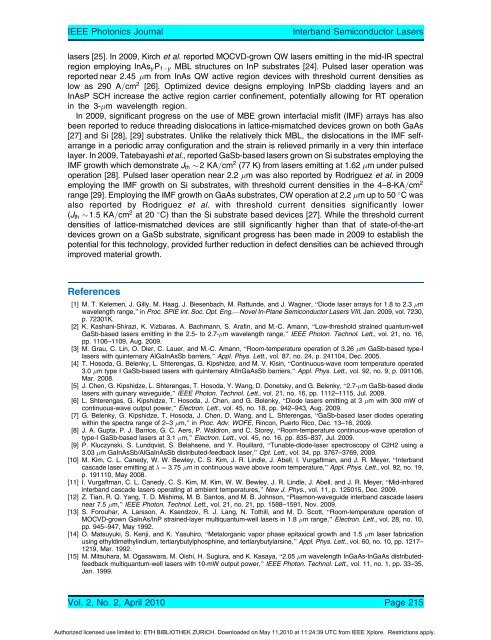Breakthroughs Breakthroughs - ETH - Ultrafast Laser Physics
Breakthroughs Breakthroughs - ETH - Ultrafast Laser Physics
Breakthroughs Breakthroughs - ETH - Ultrafast Laser Physics
You also want an ePaper? Increase the reach of your titles
YUMPU automatically turns print PDFs into web optimized ePapers that Google loves.
IEEE Photonics Journal Interband Semiconductor <strong>Laser</strong>s<br />
lasers [25]. In 2009, Kirch et al. reported MOCVD-grown QW lasers emitting in the mid-IR spectral<br />
region employing InAsyP1 y MBL structures on InP substrates [24]. Pulsed laser operation was<br />
reported near 2.45 m from InAs QW active region devices with threshold current densities as<br />
low as 290 A=cm 2 [26]. Optimized device designs employing InPSb cladding layers and an<br />
InAsP SCH increase the active region carrier confinement, potentially allowing for RT operation<br />
in the 3- m wavelength region.<br />
In 2009, significant progress on the use of MBE grown interfacial misfit (IMF) arrays has also<br />
been reported to reduce threading dislocations in lattice-mismatched devices grown on both GaAs<br />
[27] and Si [28], [29] substrates. Unlike the relatively thick MBL, the dislocations in the IMF selfarrange<br />
in a periodic array configuration and the strain is relieved primarily in a very thin interface<br />
layer. In 2009, Tatebayashi et al., reported GaSb-based lasers grown on Si substrates employing the<br />
IMF growth which demonstrate Jth 2KA=cm 2 (77 K) from lasers emitting at 1.62 m under pulsed<br />
operation [28]. Pulsed laser operation near 2.2 m was also reported by Rodriguez et al. in 2009<br />
employing the IMF growth on Si substrates, with threshold current densities in the 4–8-KA=cm 2<br />
range [29]. Employing the IMF growth on GaAs substrates, CW operation at 2.2 mupto50 C was<br />
also reported by Rodriguez et al. with threshold current densities significantly lower<br />
(Jth 1:5 KA=cm 2 at 20 C) than the Si substrate based devices [27]. While the threshold current<br />
densities of lattice-mismatched devices are still significantly higher than that of state-of-the-art<br />
devices grown on a GaSb substrate, significant progress has been made in 2009 to establish the<br />
potential for this technology, provided further reduction in defect densities can be achieved through<br />
improved material growth.<br />
References<br />
[1] M. T. Kelemen, J. Gilly, M. Haag, J. Biesenbach, M. Rattunde, and J. Wagner, BDiode laser arrays for 1.8 to 2.3 m<br />
wavelength range,[ in Proc. SPIE Int. Soc. Opt. Eng.VNovel In-Plane Semiconductor <strong>Laser</strong>s VIII, Jan. 2009, vol. 7230,<br />
p. 72301K.<br />
[2] K. Kashani-Shirazi, K. Vizbaras, A. Bachmann, S. Arafin, and M.-C. Amann, BLow-threshold strained quantum-well<br />
GaSb-based lasers emitting in the 2.5- to 2.7- m wavelength range,[ IEEE Photon. Technol. Lett., vol. 21, no. 16,<br />
pp. 1106–1109, Aug. 2009.<br />
[3] M. Grau, C. Lin, O. Dier, C. Lauer, and M.-C. Amann, BRoom-temperature operation of 3.26 m GaSb-based type-I<br />
lasers with quinternary AlGaInAsSb barriers,[ Appl. Phys. Lett., vol. 87, no. 24, p. 241104, Dec. 2005.<br />
[4] T. Hosoda, G. Belenky, L. Shterengas, G. Kipshidze, and M. V. Kisin, BContinuous-wave room temperature operated<br />
3.0 m type I GaSb-based lasers with quinternary AlInGaAsSb barriers,[ Appl. Phys. Lett., vol. 92, no. 9, p. 091106,<br />
Mar. 2008.<br />
[5] J. Chen, G. Kipshidze, L. Shterengas, T. Hosoda, Y. Wang, D. Donetsky, and G. Belenky, B2.7- m GaSb-based diode<br />
lasers with quinary waveguide,[ IEEE Photon. Technol. Lett., vol. 21, no. 16, pp. 1112–1115, Jul. 2009.<br />
[6] L. Shterengas, G. Kipshidze, T. Hosoda, J. Chen, and G. Belenky, BDiode lasers emitting at 3 m with 300 mW of<br />
continuous-wave output power,[ Electron. Lett., vol. 45, no. 18, pp. 942–943, Aug. 2009.<br />
[7] G. Belenky, G. Kipshidze, T. Hosoda, J. Chen, D. Wang, and L. Shterengas, BGaSb-based laser diodes operating<br />
within the spectra range of 2–3 m,[ in Proc. Adv. WOFE, Rincon, Puerto Rico, Dec. 13–16, 2009.<br />
[8] J. A. Gupta, P. J. Barrios, G. C. Aers, P. Waldron, and C. Storey, BRoom-temperature continuous-wave operation of<br />
type-I GaSb-based lasers at 3.1 m,[ Electron. Lett., vol. 45, no. 16, pp. 835–837, Jul. 2009.<br />
[9] P. Kluczynski, S. Lundqvist, S. Belahsene, and Y. Rouillard, BTunable-diode-laser spectroscopy of C2H2 using a<br />
3.03 m GaInAsSb/AlGaInAsSb distributed-feedback laser,[ Opt. Lett., vol. 34, pp. 3767–3769, 2009.<br />
[10] M. Kim, C. L. Canedy, W. W. Bewley, C. S. Kim, J. R. Lindle, J. Abell, I. Vurgaftman, and J. R. Meyer, BInterband<br />
cascade laser emitting at ¼ 3:75 m in continuous wave above room temperature,[ Appl. Phys. Lett., vol. 92, no. 19,<br />
p. 191110, May 2008.<br />
[11] I. Vurgaftman, C. L. Canedy, C. S. Kim, M. Kim, W. W. Bewley, J. R. Lindle, J. Abell, and J. R. Meyer, BMid-infrared<br />
interband cascade lasers operating at ambient temperatures,[ New J. Phys., vol. 11, p. 125015, Dec. 2009.<br />
[12] Z. Tian, R. Q. Yang, T. D. Mishima, M. B. Santos, and M. B. Johnson, BPlasmon-waveguide interband cascade lasers<br />
near 7.5 m,[ IEEE Photon. Technol. Lett., vol. 21, no. 21, pp. 1588–1591, Nov. 2009.<br />
[13] S. Forouhar, A. Larsson, A. Ksendzov, R. J. Lang, N. Tothill, and M. D. Scott, BRoom-temperature operation of<br />
MOCVD-grown GaInAs/InP strained-layer multiquantum-well lasers in 1.8 m range,[ Electron. Lett., vol. 28, no. 10,<br />
pp. 945–947, May 1992.<br />
[14] O. Matsuyuki, S. Kenji, and K. Yasuhiro, BMetalorganic vapor phase epitaxical growth and 1.5 m laser fabrication<br />
using ethyldimethylindium, tertiarybutylphosphine, and tertiarybutylarsine,[ Appl. Phys. Lett., vol. 60, no. 10, pp. 1217–<br />
1219, Mar. 1992.<br />
[15] M. Mitsuhara, M. Ogasawara, M. Oishi, H. Sugiura, and K. Kasaya, B2.05 m wavelength InGaAs-InGaAs distributedfeedback<br />
multiquantum-well lasers with 10-mW output power,[ IEEE Photon. Technol. Lett., vol. 11, no. 1, pp. 33–35,<br />
Jan. 1999.<br />
Vol. 2, No. 2, April 2010 Page 215<br />
Authorized licensed use limited to: <strong>ETH</strong> BIBLIOTHEK ZURICH. Downloaded on May 11,2010 at 11:24:39 UTC from IEEE Xplore. Restrictions apply.

















